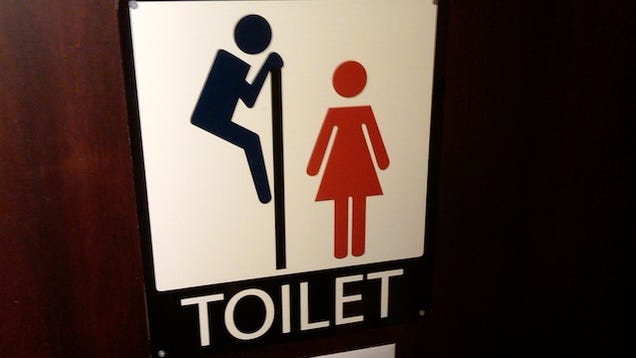
Travis Springer, an English teacher at a Washington language institute, was outside drinking coffee with a friend the other day when he was asked an unusual question, but one that divides folks nationwide:
Which is better, automatic or manual flush toilets?
Springer's views echo a perennial debate about public bathrooms across the country: to flush or to auto-flush. And they may be occurring with increasing frequency as automatic flush toilets have become more commonplace.
The first patents for automatic flush toilets surfaced in the 1970s and 1980s. Clients were wowed by their hygienic offerings and the fact that toilets would actually flush each time they're used, avoiding that maintenance headache of a mess that's been left in a toilet for hours. Industry-wide, sales for automatic flush fixtures have doubled in the past decade, said Orkun Onur, commercial product manager at Kohler, the large plumbing-fixtures company. Onur credited this to automatic toilets' decreasing price and improved technology, but he did not provide any precise data.
Despite that massive boost in sales, these toilets have often irritated, angered and perplexed those taking care of their bathroom business. Users typically find it irritating when these toilets flush with the opening or closing of a stall door or with a person's slightest movements, sometimes splashing water. On the other end, some automatic flush toilets refuse to flush unless you actually press a manual button.
Scientists are not optimistic about water's future, either. A 2015 study indicates that the Southwest and Midwest is extremely likely to experience a "megadrought" in 2050 that will last as long as three decades. Drinking water, particularly for major cities such as Phoenix and Los Angeles, will be limited.
That concerns water-efficiency experts such as John Koeller. The Orange County, Calif.-based researcher co-authored a 2010 study comparing manual and automatic plumbing fixtures in a Tampa office building over a 23-month period. Automatic flush toilets use 54 percent more water than their manual cousins. The tendency of automatics to flush when you sit or squat can add up to a lot of wasted water. Manual toilets allow the option of water-saving dual-flush technology.
“Nothing can beat a manual flush in terms of water efficiency,” Koeller said. “One visit, one flush. That's my mantra.”
There’s not much financial incentive to obsess over water conservation, though. Water prices in the United States are much lower than in other countries; it’s as much as 2.7 times as pricey in Germany, for example. We also use twice as much water per capita than themedian of all countries, as tracked by the Organization for Economic Cooperation and Development.
The industry is starting to respond to environmental concerns. Kohler's Onur said the plumbing industry is increasingly concerned with making fixtures that use less water, whether that's toilets that don't flush multiple times per use or use less water in a single flush. "That is one of the biggest hurdles that we are trying to [overcome]," he said.
Anica Landreneau, who directs sustainable design at architecture, engineering and design firm HOK, said the technology already has improved. For instance, toilets are less likely to go off when a sensor detects a light reflected from a chrome bathroom stall.
"I won't say that every manufacturer has it right, but I would say they are evolving and they are sensitive to that feedback when they get it," Landreneau said.
But that's only a change for those buying new toilets. Considering that toilets can last more than 20 years and can cost more than $800 per unit, there is not much toilet-turnover.
Still, the perception that dangerous germs are lingering everywhere in your bathroom has led building managers to go with touchless toilets, sinks, faucets and towel dispensers. At the same time, automatics have also gotten a lot cheaper. For instance, a sensor costs a quarter of what it did in 2006. "The things that we wanted to do are more doable now because the price went down significantly," Onur said.
Now, toilets are even looking toward a future of cloud computing. Building managers will be able to analyze how many flushes and how much water an automatic toilet is using, just as they are able to monitor air-conditioning and electricity usage.
Low-tech or high-tech, bathroom fixtures tend to get a lot of attention when Landreneau talks to clients about their properties. “Sometimes, I end up talking about water fixtures more than anything else," she said.
source: https://www.washingtonpost.com/news/wonk/wp/2016/06/22/the-case-for-flushing-your-own-toilet/
by Rachel Premack
http://www.thisoldtoilet.com




